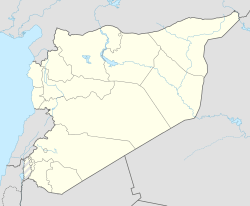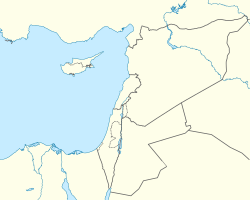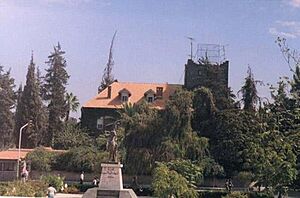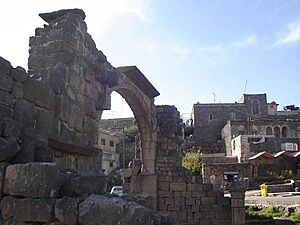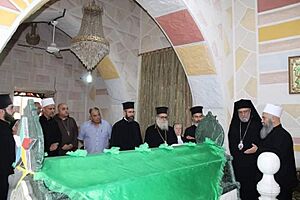As-Suwayda facts for kids
Quick facts for kids
As-Suwayda
ٱلسُّوَيْدَاء
|
|
|---|---|
|
City
|
|
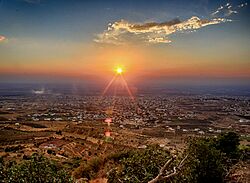
Aerial view of the Suwayda city, October 2011
|
|
| Country | |
| Governorate | As-Suwayda |
| District | As-Suwayda |
| Subdistrict | As-Suwayda |
| Elevation | 3,543 ft (1,080 m) |
| Population
(2020 census)
|
|
| • City | 120.000 |
| • Metro | 138,822 |
| Demonym(s) | Arabic: سويداوي, romanized: Suwaydāwi |
| Time zone | UTC+2 (EET) |
| • Summer (DST) | UTC+3 (EEST) |
| Area code(s) | 16 |
| Geocode | C6147 |
| Climate | Csa |
As-Suwayda (Arabic: ٱلسُّوَيْدَاء), also called Sweida, is a city in southwestern Syria. It is located near the border with Jordan. Most people living in As-Suwayda are Druze, a religious and ethnic group.
As-Suwayda is the capital city of the As-Suwayda Governorate. This is one of Syria's 14 main regions. The city is sometimes called "Little Venezuela." This is because many wealthy people from Venezuela who have Syrian family roots have moved there.
Contents
A Look Back: As-Suwayda's History
Ancient Times
The city was first built by the Nabataeans. They called it Suada. Later, during the Hellenistic period and the Roman Empire, it became known as Dionysias Soada. This name came from the Greek god Dionysus, who was linked to wine. As-Suwayda was famous for making wine a long time ago.
The name Dionysias was used from 149 AD. This happened after the Nabataean people had less influence in the area. Dionysias was part of the Roman province called Arabia Petraea. It gained special city rights between 180 and 185 AD.
People in Dionysias worshipped Dionysus in the same temple where the Nabataean god Dushara was worshipped. This was common in ancient Syria. People often combined the worship of local gods with Greek gods.
Medieval and Ottoman Eras
The name Dionysias was still used during the Byzantine Empire. At that time, the city was influenced by the Ghassanids, an Arab kingdom. Dionysias was also a diocese, which is an area managed by a bishop.
In 629 AD, Arab armies from the Rashidun Caliphate took control of the city. Later, in the 1220s, a writer named Yaqut al-Hamawi described As-Suwayda as a "village of the Hauran Province."
In 1516, the Ottoman Empire took over the city from the Mamluk Sultanate. In Ottoman records from 1596, As-Suwayda was called Majdal Sawda. It was a small village with Muslim families. They paid taxes on their crops and animals.
In the 19th century, visitors saw the Tomb of Hamrath in As-Suwayda. This was a detailed ancient tomb from the 1st century BCE, but it is now destroyed.
Modern Times
The city of As-Suwayda has been controlled by the Syrian government throughout the Syrian Civil War. In October 2012, security forces made many arrests in the city.
Protests in As-Suwayda
People in As-Suwayda have held protests to express their concerns about the economy and living conditions.
2020 Protests
On June 7, 2020, protests started in the city. People were unhappy about the difficult economic situation. For the first time since 2015, some protesters asked for the president, Bashar al-Assad, to step down. After these protests, the Prime Minister, Imad Khamis, was replaced by Hussein Arnous on June 11.
2022 and 2023 Protests
In February 2022, hundreds of people protested in Sweida. They spoke out against corruption and worsening living standards.
In August 2023, thousands of protesters gathered. They were upset about the economy and again asked for the Syrian President to leave office.
People of As-Suwayda
Most people living in As-Suwayda are Druze. There are also smaller groups of Greek Orthodox Christians and Sunni Muslims.
In 2004, the population of the entire As-Suwayda Governorate was about 313,231 people.
Ancient Discoveries
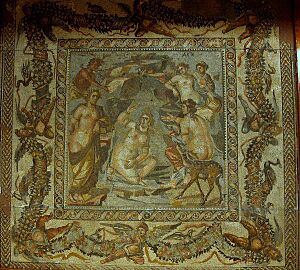
Many old and interesting sites can be found in the historic part of As-Suwayda:
- Temple of Dionysus-Dushara: Eight decorated columns from this old temple are still standing today.
- Saint Sergius Basilica: This church was built in the fifth century. It has Byzantine design elements and was surrounded by an abbey. It was dedicated to a saint named Sergius.
- The Arch of the Lesser Church: The church itself is now in ruins, but an arch still stands. Locals call it "The Gallows" (al-Mashnaqah). It has beautiful grape designs carved into it.
- The Theater: This ancient theater was found recently, south of the Agora (a public meeting place).
The city also has many old water reservoirs, towers, and Roman houses. Some of these Roman houses are still used by people living there today!
Many parts of the old city are still waiting to be explored by archaeologists. These include a Roman aqueduct (a water channel), a cone-shaped reservoir, and a larger Roman theater. There is also an old mosque from the 7th century, built during the time of the Rashidun Caliphate.
Weather in As-Suwayda
As-Suwayda has a warm, dry, and mild climate. It gets more rain in the winter than in the summer. This type of climate is called BSk by climate scientists. The average temperature in As-Suwayda is about 15.5°C (59.9°F). Around 323 millimeters (12.7 inches) of rain falls each year.
| Climate data for As-Suwayda | |||||||||||||
|---|---|---|---|---|---|---|---|---|---|---|---|---|---|
| Month | Jan | Feb | Mar | Apr | May | Jun | Jul | Aug | Sep | Oct | Nov | Dec | Year |
| Mean daily maximum °C (°F) | 10.5 (50.9) |
11.7 (53.1) |
15.2 (59.4) |
20.1 (68.2) |
25.4 (77.7) |
29.2 (84.6) |
30.1 (86.2) |
30.9 (87.6) |
29.2 (84.6) |
26.0 (78.8) |
19.1 (66.4) |
12.8 (55.0) |
21.7 (71.0) |
| Daily mean °C (°F) | 6.2 (43.2) |
7.1 (44.8) |
10.0 (50.0) |
13.9 (57.0) |
18.3 (64.9) |
21.7 (71.1) |
22.8 (73.0) |
23.5 (74.3) |
21.8 (71.2) |
18.9 (66.0) |
13.6 (56.5) |
8.3 (46.9) |
15.5 (59.9) |
| Mean daily minimum °C (°F) | 1.9 (35.4) |
2.6 (36.7) |
4.8 (40.6) |
7.8 (46.0) |
11.3 (52.3) |
14.2 (57.6) |
15.6 (60.1) |
16.1 (61.0) |
14.4 (57.9) |
11.8 (53.2) |
8.1 (46.6) |
3.9 (39.0) |
9.4 (48.9) |
| Average precipitation mm (inches) | 69 (2.7) |
71 (2.8) |
57 (2.2) |
21 (0.8) |
8 (0.3) |
0 (0) |
0 (0) |
0 (0) |
1 (0.0) |
11 (0.4) |
27 (1.1) |
58 (2.3) |
323 (12.6) |
| Source: Climate-Data.org | |||||||||||||
Famous People from As-Suwayda
- Najat Abdul Samad, a writer, translator, and doctor.
- Fahd Ballan, a singer and actor.
- Asmahan, a famous singer.
See also
 In Spanish: As-Suwayda para niños
In Spanish: As-Suwayda para niños


